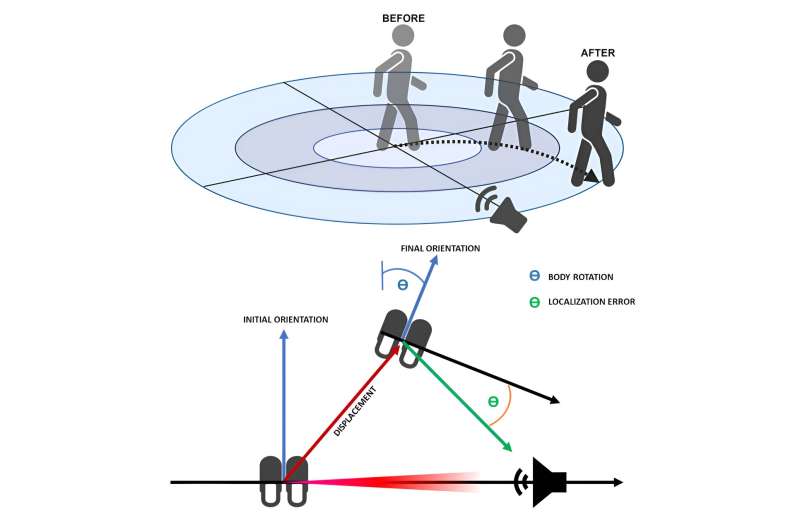This article has been reviewed according to Science X's editorial process and policies. Editors have highlighted the following attributes while ensuring the content's credibility:
fact-checked
peer-reviewed publication
trusted source
proofread
What happens when auditory cues affect body representation and vice-versa?

Picture this test: You stand with your eyes closed and arms stretched in front of you while a voice from a stationary loudspeaker located two meters away narrates a series of sentences. Then you're asked to walk on the spot for 60 seconds, making an effort to stay in the same place by using the continued auditory cues to orient you.
What do you notice when you open your eyes a minute later?
Despite your best efforts to stay on the same spot, you've actually moved forward and veered 26 degrees (on average) toward the speaker, which was initially positioned 90 degrees from your right ear.
What caused the deviation? The culprits are your auditory and body representation systems, which interfere with each other.
These are the findings of Daniel Paromov's Ph.D. research, which was conducted under the supervision of François Champoux from Université de Montréal's School of Speech Therapy and Audiology. The results have been published in iScience.
Disrupting the senses to understand them better
As one of the many senses we rely on for spatial localization, the auditory system contributes to the brain's representation of the body. While many studies have confirmed that auditory cues influence body perception and movement-related activity, the influence of body representation on spatial hearing was essentially unexplored prior to this study.
In other words, we knew that what we hear could affect the way we feel and move, but we didn't know whether the way we feel and move could affect what we hear.
This is what Paromov wanted to find out. He recruited 20 people to participate in an experiment during which their auditory information processing would be disrupted.
Tricked by the auditory system
Participants were blindfolded and asked to stand at a standard distance of two meters from the loudspeaker, which was positioned at either 0, 45 or 90 degrees from the direction they were facing. At this stage, all participants correctly identified where the voice was coming from; they were able to determine the speaker's position with minimal error.
Next, they were asked to close their eyes and walk on the spot at a rate of two steps per second, for 60 seconds. The goal was to stay in the same place and maintain the same angle in relation to the voice. All participants were asked to repeat the exercise three times.
In all cases, participants tended to move forward and veer to one side. Those who were facing the loudspeaker (0 degrees) had a mean deviation of 13 degrees. The mean deviation was 24 degrees when the speaker was placed at 45 degrees, and 26 degrees when the sound came from 90 degrees to the right.
Body rotations of up to 77 degrees were observed following the stepping task.
An unbalanced interaction
Without visual input, the interaction between the auditory and sensorimotor systems is unbalanced. As a result, changes in body orientation generate an illusory shift in sound source localization.
"To determine its position in space, the brain integrates information from different senses and, through this process, generates a coherent and apparently seamless perception of the external world," explained Paromov. When the brain combines information from different senses, this information usually comes from related events. But when the information is discordant, it can cause inaccurate perceptions.
"The key takeaway is that we were able to disrupt auditory perception by creating a simple illusion in the representation of the body in space," added Paromov. "This indicates a reciprocal association between the auditory system and body representation. Previously, we didn't know that the systems were mutually influential."
François Champoux, who oversaw the study, says these findings change how we think of auditory spatial perception.
"Psychoacoustics laws no longer hold true when put in relation to the other senses," explained the professor. "Our data suggest, among other things, that non-auditory sensory cues are necessary for auditory localization—and auditory localization seems practically impossible without these cues. Most of what we know about the auditory system is taken in isolation. It's time we started exploring how the auditory system interacts with the other senses if we really want to understand key issues related to perception."
An illusion that could have concrete implications
Champoux believes the auditory illusion that Paromov produced is the strongest observed to date in a localization task.
"People are usually very good at this type of localization, so a 26-degree deviation is huge," Champoux explained. "What makes this illusion impressive is that the task is so simple, but the result is so striking. The finding is plain for everyone to see."
In Paromov's view, this fundamental research project has not only demonstrated the reciprocal interactions, but it could contribute to a number of practical applications.
"Our findings have opened up the possibility of learning more about certain conditions related to sensory perception, such as motion sickness, or the way the brain reacts to the spatial illusion created by virtual reality," concluded the Ph.D. student.
More information: Daniel Paromov et al, Body representation drives auditory spatial perception, iScience (2024). DOI: 10.1016/j.isci.2024.109196



















